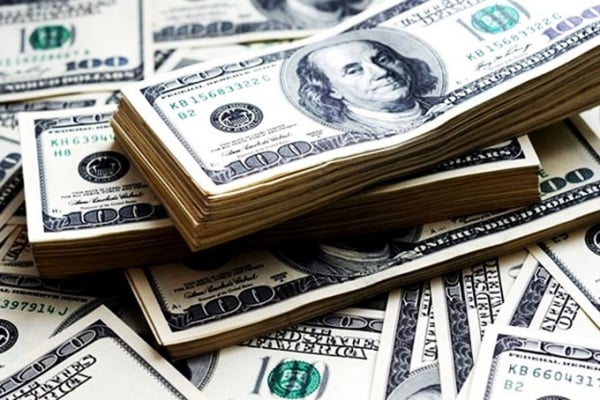US retail sales rose in December as households bought motor vehicles and a variety of other goods, pointing to strong demand in the economy.
US retail sales rose in December 2024 as households bought motor vehicles and a variety of other goods, indicating strong demand in the economy and reinforcing the US Federal Reserve's cautious approach to cutting interest rates in 2025.
Rising wages boost consumer spending
The report from the US Commerce Department on January 16 prompted some economists to raise their forecasts for fourth-quarter economic growth to nearly the same level as the third quarter. The report came after news of a sharp increase in nonfarm payrolls in December and a decline in the unemployment rate from 4.2% in November to 4.1% in December.
 |
| Retail sales rose 0.4% in December 2024 after rising 0.8% in November, according to the US Department of Commerce's Bureau of Statistics - Illustration photo |
Although core inflation eased last month, overall consumer prices rose at their fastest pace in nine months. A strong labor market with higher wage growth is boosting consumer spending.
“ No one would argue that the Fed needs to cut rates immediately based on this retail sales report ,” said Carl Weinberg, chief economist at High Frequency Economics. “ There is no need for monetary stimulus when the economy is already at full employment .”
Retail sales rose 0.4% last month after increasing 0.8% in November, according to the U.S. Commerce Department's Bureau of Statistics. Economists polled by Reuters had forecast retail sales, which include mostly goods and are not adjusted for inflation, would rise 0.6% after rising 0.7% in November. Retail sales in December 2024 increased 3.9% compared to the same month in 2023.
Sales at car dealerships rose 0.7% after rising 3.1% in November. Sales at furniture stores rose 2.3%, while sales at clothing stores rose 1.5%.
Sales at sporting goods, recreational goods, musical instruments and book stores rose 2.6%. Sales at other retail stores, which include gift shops and florists, rose 4.3%.
Online sales rose just 0.2%. However, sales at food service establishments and bars fell 0.3% after a slight 0.1% gain in November. Economists consider eating out an important indicator of household finances. The cold weather may have kept consumers at home.
Sales at building materials stores fell 2.0%, while higher gasoline prices boosted sales at gas stations by 1.5%.
Surveys suggest consumers may be rushing to stock up on goods ahead of tariffs from the incoming administration of President-elect Donald Trump. Trump, who takes office next week, has pledged to impose broad tariffs on imported goods, which could raise prices for consumers.
Core sales growth is strong
Retail sales, excluding automobiles, gasoline, building materials and food services, rose 0.7% last month after rising 0.4% in November. This type of core retail sales is most closely correlated with the consumer spending component of gross domestic product (GDP).
Economists estimate consumer spending grew at an annual rate of 3.3% in the fourth quarter, after rising 3.7% in the third quarter. Capital Economics raised its GDP growth forecast for the final quarter of 2024 to 2.9%, from 2.7% previously.
The economy grew 3.1% in the third quarter, significantly faster than the 1.8% rate that US central bank officials consider a non-inflationary growth rate.
The Fed is not expected to cut interest rates this month after forecasting just two cuts this year, down from four in September when it began its easing cycle. This points to potential risks from President-elect Donald Trump’s policies, including mass deportations of undocumented immigrants and tax cuts that are seen as inflationary.
Federal Reserve Governor Christopher Waller expressed hope on January 16 that inflation will continue to decline, potentially allowing the central bank to cut interest rates sooner and more quickly than expected.
US government bond yields fell after Christopher Waller's comments, while the US dollar lost value. Stock prices on Wall Street fell.
The Fed cut its overnight interest rate by 100 basis points to a range of 4.25%-4.50%, after raising it by 5.25 percentage points in 2022 and 2023.
“ Tariffs remain the main risk this year, and the burden of higher inflation on consumer goods will hit lower-income households, increasing the risk of a consumer divide in the US ,” said Michael Pearce, deputy director of US economics at Oxford Economics.
Low-income households are struggling, with little or no savings to fall back on. A report from the Labor Department showed initial jobless claims rose 14,000 to a seasonally adjusted 217,000 for the week ended Jan. 11. Economists had forecast 210,000 claims for the week.
Claims data, which tend to fluctuate at the start of the year, continue to show low layoffs. Last week’s claims were likely boosted by unusually cold weather, with unadjusted claims rising by 15,175 in Michigan. There were also significant increases in Illinois, Ohio and Missouri.
Claims rose by 13,074 in California. Economists are divided on whether wildfires were the main cause.
The Fed's January 15 Beige Book report described employment as " a modest increase " in January. The report said " feedback from many sectors indicated difficulties in recruiting skilled workers, while reports of layoffs were low ," but added that " some sectors expressed growing concerns about future staffing needs not increasing ."
The number of people receiving benefits after the first week, a proxy for hiring, fell 18,000 to 1.859 million in the week ended Jan. 4, according to the initial claims report.
“ The labor market will remain strong in 2025 ,” said Stuart Hoffman, senior economic advisor at PNC Financial Services Group (USA). “ A potential risk to job growth is the possibility of immigration restrictions from the incoming administration, which would reduce the number of available workers .”
| Although core inflation eased in December 2024, overall consumer prices rose at their fastest pace in nine months. A strong labor market with higher wage growth is boosting consumer spending. |
Source: https://congthuong.vn/doanh-so-ban-le-my-tang-thi-truong-lao-dong-vung-chac-370089.html



![[Photo] Prime Minister Pham Minh Chinh chairs meeting to urge highway projects](https://vstatic.vietnam.vn/vietnam/resource/IMAGE/2025/3/29/6a3e175f69ea45f8bfc3c272cde3e27a)
![[Photo] Prime Minister Pham Minh Chinh and Brazilian President Luiz Inácio Lula da Silva attend the Vietnam-Brazil Economic Forum](https://vstatic.vietnam.vn/vietnam/resource/IMAGE/2025/3/29/f3fd11b0421949878011a8f5da318635)


![[Photo] Dong Ho Paintings - Old Styles Tell Modern Stories](https://vstatic.vietnam.vn/vietnam/resource/IMAGE/2025/3/29/317613ad8519462488572377727dda93)













































































![[REVIEW OCOP] An Lanh Huong Vet Yen Cat](https://vstatic.vietnam.vn/vietnam/resource/IMAGE/2025/3/27/c25032328e9a47be9991d5be7c0cad8c)










Comment (0)